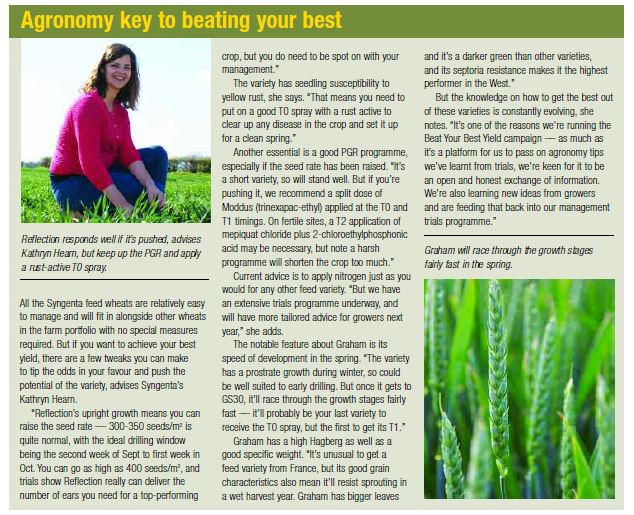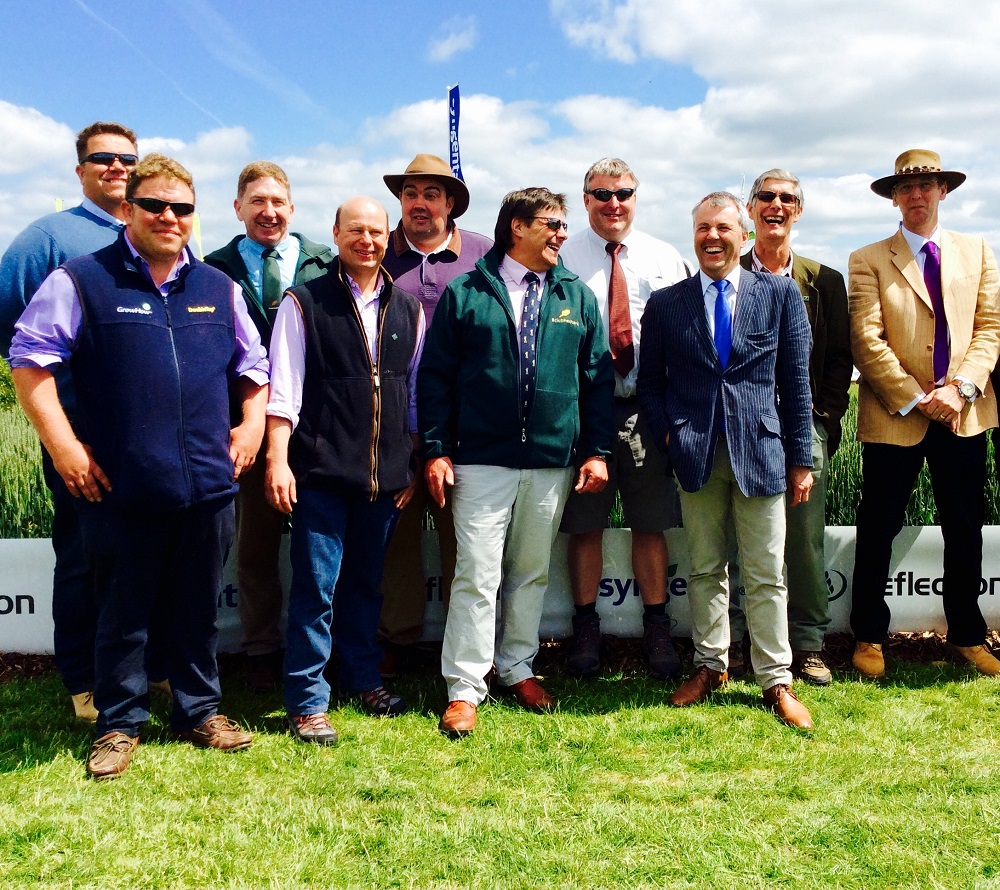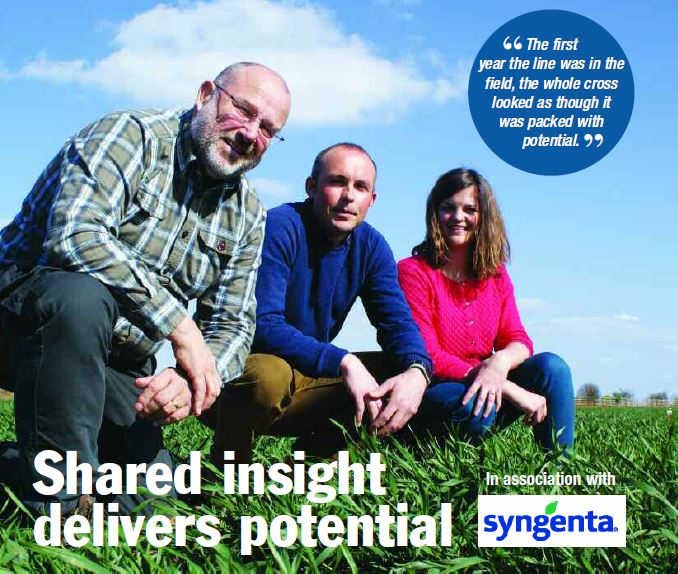
Ten #Clubhectare members are some of the growers who have taken up the challenge to beat their best wheat yield with a crop of Reflection. CPM gets an insight into the Syngenta wheat-breeding programme and gleans progress from the field.
By Tom Allen-Stevens
Wandering through the breeding lines in the Syngenta plots at Whittlesford, Cambs, you wonder which of the numbered wheat varieties may be future rising stars on the AHDB Cereals and Oilseeds Recommended List.
It’s clearly something that preoccupies senior wheat breeders David Feuerhelm and Duncan Warner, although they’re not going to pin their colours to the mast and say which of the thousands of lines waving their leaves in the spring sunshine, have the brightest prospects.
“Every year you can guarantee there’ll be one cross you’ve been looking forward to that’ll disappoint and then another that’ll surprise you,” notes David Feuerhelm.
Reflection, however, was one variety that showed its potential from the off, he reveals. “The first year the line was in the field, the whole cross looked as though it was packed with potential. In yield trials, the Reflection plots were full of ears, and these were tight with grain. Putting the combine through just confirmed everything we knew.”
High-yielding feed wheat
Since 2006, the Syngenta wheat-breeding programme has been ramped up, with 70% of crosses now targeting the high-yielding feed wheat market. With glasshouse facilities at Jealotts’s Hill in Berks, along with its base at Whittlesford, the aim is to be the biggest UK wheat breeder.
“It’s a highly focused programme and there’s a strong integration of technology through the use of doubled-haploid methods and marker-assisted selection along with single-seed descent,” continues David Feuerhelm. “That means we can be very efficient at bringing high-yielding feed wheats with good agronomics to the market.”
The programme started as New Farm Crops with varieties such as Apollo in the 1980s, Reaper recommended in 1998, and more recently Duxford, which first appeared on the 2007 RL and went to take an 8% market share. A focus on high yield potential with good grain quality resulted in Group 1 lead variety Gallant, recommended in 2009, followed closely by Ketchum and Kingdom.
Hard Group 4 Reflection leads the new focus on feed wheats, and currently holds a 10% share of the certified seed market, having debuted on the RL as the highest yielding newcomer last year. New on the list this year is Graham, one of only two varieties on the RL with a score of 7 for Septoria tritici and boasting the third highest untreated yield. Candidate varieties Savello and Shabras look to be strong contenders in the soft and hard Group 4 categories respectively.
“Reflection brings more than just high yields,” explains David Feuerhelm. “It also brings orange wheat blossom midge resistance, high specific weight and early maturity.
“One aspect you notice about it is that it’s relatively short – it stands very upright and its leaves are erect. This allows good penetration to the lower leaves for sunlight and fungicides.”
Wheat yield record
This is one of the features that Lincs grower Tim Lamyman claims drew him to the variety with which he succeeded in breaking the world wheat yield record in 2015, achieving 16.5t/ha. “Whether the leaf angle is the whole story is up for debate – when it comes to yield in wheat there is no ideotype. Every high-yielding variety has its characteristics that, nurtured well, will bring out the potential,” notes David Feuerhelm.
“But when it comes to maturity, Reflection breaks the mould of most high performers that tend to ripen late – it’s much earlier to harvest, which is a feature favoured by many growers.”
Graham comes from a very different background and was originally a cross in Syngenta’s French programme, explains Duncan Warner. “We test a number of varieties from across the Syngenta European programme for National List trials, and Graham seemed to be suited to UK conditions. We put it into our NL-1 trials for 2012 harvest and it stood out as a variety with great potential.”
It’s a cross of Premio, an RAGT line, with Expert, a Syngenta variety that’s performed well in northern France. “Neither parents have fantastic Septoria tritici scores, but it’s the accumulation of genes from both that’s given it the very robust and stable disease profile,” he continues.
“What you notice in the field is a fantastic finish – the way the ear develops is very pleasing to see and, like Reflection, there’s a good specific weight. It also matures earlier than Reflection, with a harvest date closer to Cordiale.”
The candidate hopefuls Savello and Shabras are both from the same parents – Cassius and Hereford. “Cassius is a Limagrain soft wheat variety recommended for the North with good disease resistance, apart from Septoria tritici. That’s supplied by Hereford, a Sejet variety that yields, particularly as a second wheat, and also has good yellow rust resistance.”
Earliness is again a feature of both these RL candidates, with some quick spring regrowth. But there’s one very different variety Syngenta has in NL2, that was the top-yielding variety from 2015 NL1 trials. “It’s a hard Group 4 with good all round disease resistance. An early drilled variety, it’s slow and steady in the spring and matures late,” says Duncan Warner.
Currently just a coded line, it’s one of a number of prospects offering something different for the future. “When Reflection first came through, we had very little in feed wheats, but now there’s a promising pipeline,” he adds.

A challenging spring
Reflection has got off to a strong start, according to the ten #Clubhectare growers trying the variety for the first time. Signs of the seedling susceptibility to yellow rust caused concern initially, especially for those in eastern counties, but this now appears to be in check.
“I’m generally quite pleased with my crop at the moment,” says Peter Gadd, with a 24ha field at Stragglethorpe in South Notts. Combination-drilled on 2 Oct with a 4m Accord drill atop a Kuhn power harrow into clay loam at 355 seeds/m², it benefited from biosolids after the previous oilseed rape crop.
“In retrospect, we should have added a manganese seed dressing – we’ve noticed deficiency patches showing through. But generally, the crop looked well in the autumn and went into the winter in a good state.”

The ten #Clubhectare #beatyourbest challenge growers (L to R): Keith Challen, Charles Anyan, Chris Hewis, James Stafford, Pip Partridge, Jono Dixon, David Watson, Andrew Ward, Andrew Watts, Peter Gadd.
Small pustules of yellow rust appeared early in the spring, which dried up following a T0 spray of chlorothalonil and cyproconazole on 3 April. “Conscious of the crop’s potential, I wasn’t going to take any chances at T1, so added pyraclostrobin to the bixafen/prothioconazole/spiroxamine mix applied on 17 April.”
He held back on the nitrogen until the end of March as the crop was looking healthy from the biosolids, and the total applied will be around 210kgN/ha. “It’s on course to yield, but it’s a long time to harvest,” he notes.
Near Ipswich on Hanslope clays to Melford series heavy loams, Pip Partridge also has confidence in his 30ha crop of Reflection. “It should yield, but it’ll cost a little more to get there than we’d hoped,” he says.
It was established at 350 seeds/m² on the last day of Sept with starter fertiliser applied through the Väderstad Rapid. “The crop really flew out of the ground and looked fantastic,” he notes.
Early yellow rust has been checked by Cherokee (chlorothalonil+ cyproconazole+ propiconazole) applied at T0, and three splits of liquid fertiliser (26N:5SO3) brings the total applied to 200kgN/ha. “We’re also using a bit of ‘muck and magic’ – we put some Mega-Fos (phosphite) on with the T0 to improve rooting and nutrient uptake, so trying every aspect to pull out the potential.”
The early yellow rust came as a bit of a surprise for Charles Anyan with a 6.8ha crop at Gainsborough, Lincs. “It appeared after the T0 spray had gone on, but the T1 stopped it in its tracks. We put on epoxiconazole plus boscalid plus chlorothalonil on 22 April and the new leaves are now clean,” he reports.
Drilled in his “kindest” sandy clay-loam field with a 6m Kuhn Megant, following plough and power harrow after OSR, the crop tillered well and looks good, he says. A total of 220kgN/ha has been applied in three splits, including the first as Double Top.
Andrew Ward, near Leadenham, Lincs, is growing Reflection alongside Revelation and Dickens, which both have a 9 rating for yellow rust. There’s a farm trial following a catch crop and this was drilled to wheat on 16 Oct – the farm’s Simba Freeflow drill was pitched against a John Deere 750A direct drill.
“The crop established with the Freeflow is streaks ahead. What’s more, the other varieties are clean as a whistle, but we had some early yellow rust in the Reflection.”
This has been checked with the T0 spray and new growth is green, he says – all varieties were treated with tebuconazole plus chlorothalonil. 180kgN/ha has been applied in three splits as liquid 30%N.
“For me, the real benefit of this challenge has been the interest and the interaction we’ve had on Twitter – we’re all learning from each other and getting to grips with this variety. But the jury’s out on it so far – we’ll have to see how it performs at harvest,” he says.
On Sunk Island, north of the Humber, Jono Dixon has seen very little of the disease that’s dogged growers further south. “I think I benefit from the sea air here. But soil condition makes a difference – we’ve an easement that 3-4 years back, went across the field where the Reflection is now, and the stressed crop was noticeably more spotted with yellow rust.”
With 8ha of Reflection on warp land after vining peas, he’s hopeful of achieving a 12.5t/ha crop. A T1 spray of fluxapyroxad, pyraclostrobin and epoxiconazole plus Bravo (chlorothalonil) followed a T0 of Bravo plus epoxiconazole. A total of 190kgN/ha has gone on in two splits.
But like Andrew Ward, he’s learning from the others involved in the challenge. “Not a day goes by that you don’t find out something new.”
Further north at Cockle Park on the Newcastle University farm, David Watson reports his 20ha crop is clean, as is the untreated Reflection in Frontier trials on the farm.
“We drilled in the second week in Sept into heavy clay. It came through nice and even and hasn’t looked back,” he says. A T0 spray of tebuconazole plus chlorothalonil was applied in the first week of April with the T1 planned for mid May. 200kgN/ha is being applied in total in three splits.
“It looks a promising crop of wheat – good and solid – but not much different from other varieties. Last year we had exceptional yields, averaging 11.5t/ha, and I’d be surprised if the Reflection does that well, but we’ll see.”





